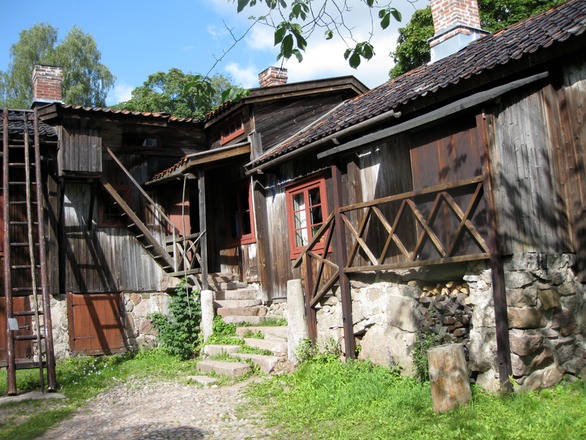It was David’s turn to feel sick: in his case, just really, really tired. So Susan drove out of Helsinki and all the way to Turku campground while David slept. Before we left the Helsinki campground, we filled the fresh water tank and dumped the black and gray water. This was the first time in 14 days that we had dumped--a record for us. But then Susan had been in the hospital for four of those days, and our St Petersburg trip kept us away for four nights. Still, we knew we were pushing our luck and decided to be careful lest we have to unplug and level again.
After sleeping for about 20 hours straight, David felt better again and we drove into Turku to visit their handicraft museum. This place is about a city block of 250-year-old wooden houses that survived the inevitable fire--this one in 1827--that had destroyed much of the city. The buildings are all in their original place and are now craft workshops and museums of a wide variety. More than half of the buildings were locked up, but it was still an interesting glimpse of what life had been like 250 years ago.

After that, we drove back to the hospital parking lot where we had parked for five nights while Susan was in the hospital. We wanted to be close to the ferry to Stockholm that was scheduled to sail early the next morning.
We were one of the last vehicles to be waved onboard the ferry . . . directed alongside a daunting row of 18-wheelers . . . just barely squeezing past . . . almost all the way to the bow of the ship . . . right in line to be one of the first ones off. We opted to shut down the refrigerator for the 12-hour trip rather than plug in to the ship’s generated current and risk some electrical problem like the one we’d had on the journey to Finland. (As it turned out, everything in the refrigerator seemed to survive without any problem.)
We had opted to pay a little extra for a private cabin (inboard; no window), so we would have a place to rest away from the many passengers who regarded the journey as a fine excuse to party--and the ship line, who encouraged this attitude by hiring Elvis-impersonators to entertain at 3:00 in the afternoon. Nevertheless, we did spend quite a bit of time at a good table right at the prow (but inside, protected from the wind). There is surprisingly little open water between Finland and Sweden, and from our table we could watch the ferry wending through the archipelago of rocky little islands as we left Turku. More than four hours later, we finally left them behind . . . only to soon be amid others like them as we approached Stockholm.
We were, indeed, one of the first off the ferry, and at the stoplight at the end of the wharf a sign directed us to the E4, so we were quickly on our way to Uppsala, 40 miles to the north. We found the city’s campground and chose a site outside its small Wifi zone rather than park closer to the antenna but next to a noisy group with children racing about and adults clearly planning a big outdoor party (do we sound like kill-joys, or what?). On Sunday we rode our bikes an easy ten minutes into the city, stopping first at the cathedral, where the choir was rehearsing for a service about to start. This cathedral is the largest in all of Scandinavia: red brick, undecorated, with two towers, each as high as the building is long.

Unlike its plain, unadorned exterior, the cathedral had quite a lot of painted detail inside. We stayed for the first part of the service, but sat way in the back so we could easily sneak out, since we didn’t think we could make it through an hour and a half service--or so it was billed--in Swedish! We went in search of museums, and even on a Sunday were able to find a couple that were open. One was the home and garden of Carl Linnaeus, the biologist responsible for some of the systematic taxonomy we all learned in Biology 101. It was a lovely “fireproof” home that had survived the fire of 1702 that destroyed much of that city. (How many places on this trip have we heard of a fire destroying an entire city? Everywhere we go, it seems.)
We fell in love with Uppsala. It is a lovely university town: tree-lined streets and boulevards, tree-lined riverfront, hundreds of bike racks filled with thousands of bicycles, flowers everywhere, students even more plentiful. It is hard to imagine it on a cold, dark midwinter day.

We stayed an extra night and went into the city again and visited the Carolina Rediviva (university library), where there is a Bible from the 6th century. And then, duly edified, we walked the shopping streets with everyone else.
We are heading east now, back to Norway. We are in Hallestammer, at our first campground with a swimming pool that is both free and open: 50 meters long, 8 lanes wide, alongside several smaller kiddie pools, all available to the public, but free to campers. We finally got our swim suits wet.
